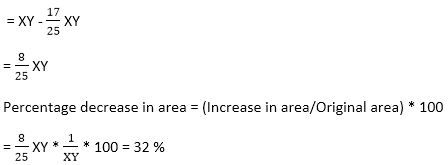Question: 21 -
The area of a parallelogram is 162 square meters. If its altitude is twice the corresponding base, find the length of the base?
-
7
-
8
-
9
-
10
Answer:
9
Solution:
Area of a parallelogram = (Base * Height)
Let the length of the base is = X
Then, the altitude or height is = 2X
So, Area: X * 2X = 162 sq. m.
2X2 = 162
X2 = 81
X = 9 meters (length of the base).
Area of a parallelogram = (Base * Height)
Let the length of the base is = X
Then, the altitude or height is = 2X
So, Area: X * 2X = 162 sq. m.
2X2 = 162
X2 = 81
X = 9 meters (length of the base).
Question: 22 -
The difference between the length and breadth of a rectangle is 25 meters. If the perimeter of this rectangle is 210 meters, what is its area?
-
3000
-
3600
-
2000
-
2600
Answer:
2600
Solution:
The perimeter: 2 (L + B) = 210 or L+ B = 105 ...... (i)
As per the question: (L - B) = 25 ....... (ii)
Solving the above two equations:
L + B = 105
B = 105 - L
Put the value of B in (ii).
L - (105 - L) = 25
L - 105 + L = 25
2L = 25 + 105
2L = 130
L = 65
So, - B = 105 - 65 = 40
Now, area of a rectangle: L *B= 65 * 40 = 2600 m2
The perimeter: 2 (L + B) = 210 or L+ B = 105 ...... (i)
As per the question: (L - B) = 25 ....... (ii)
Solving the above two equations:
L + B = 105
B = 105 - L
Put the value of B in (ii).
L - (105 - L) = 25
L - 105 + L = 25
2L = 25 + 105
2L = 130
L = 65
So, - B = 105 - 65 = 40
Now, area of a rectangle: L *B= 65 * 40 = 2600 m2
Question: 23 -
The area of a trapezium is 1500 sq. m. If the parallel sides are in the ratio of 12: 18 and the distance between the parallel sides is 32 meters, what is the length of the smaller parallel side?
-
4.5
-
5.3
-
3.3
-
6.5
Answer:
3.3
Solution:
Trapezium is a quadrilateral with one pair of parallel sides.
Let the length of the smaller side = 12x
Length of the bigger parallel side = 18x
Distance between parallel sides = 32 meters
Area of a trapezium = 1/2 * (sum of parallel sides) * distance between them.
So, as per the question: 1500 = 1/2 (12x +18x) * 30
1500 = 1/2 * 30x * 30
1500 = 30x * 15
30x = 1500 /15
30x = 100
x= 100 /30 = 3.3 meters
Trapezium is a quadrilateral with one pair of parallel sides.
Let the length of the smaller side = 12x
Length of the bigger parallel side = 18x
Distance between parallel sides = 32 meters
Area of a trapezium = 1/2 * (sum of parallel sides) * distance between them.
So, as per the question: 1500 = 1/2 (12x +18x) * 30
1500 = 1/2 * 30x * 30
1500 = 30x * 15
30x = 1500 /15
30x = 100
x= 100 /30 = 3.3 meters
Question: 24 -
The side of a rhombus is 25 m, and one of its diagonal is 30 meters. What is its area?
-
600 sq. m
-
450 sq. m
-
500 sq. m
-
400 sq. m
Answer:
600 sq. m
Solution:
Diagonal of a rhombus bisect and divide each other equally.
So, half of the given diagonal = 15 m.
Let the half of the other diagonal = X
So, as per the Pythagoras theorem: 152 + X2 = 252
225 + X2 = 625
X2 = 625 - 225
X2 = 400
X = 20
So, the length of the other diagonal is double of X: 20 + 20 = 40 m.
Now, Area of a rhombus = 1/2 * (product of diagonals)
= 1/2 * 30 * 40
= 600 sq. m.
Diagonal of a rhombus bisect and divide each other equally.
So, half of the given diagonal = 15 m.
Let the half of the other diagonal = X
So, as per the Pythagoras theorem: 152 + X2 = 252
225 + X2 = 625
X2 = 625 - 225
X2 = 400
X = 20
So, the length of the other diagonal is double of X: 20 + 20 = 40 m.
Now, Area of a rhombus = 1/2 * (product of diagonals)
= 1/2 * 30 * 40
= 600 sq. m.
Question: 25 -
A blanket, when bleached, decreases in length by 20% and in breadth by 15%. What is the percentage decrease in its area?
-
32
-
35
-
42
-
45
Answer:
32
Solution:
Let original length = X
Original breadth = Y
So, original area = XY
So, decrease in area = X*Y - 

Let original length = X
Original breadth = Y
So, original area = XY
So, decrease in area = X*Y - 
